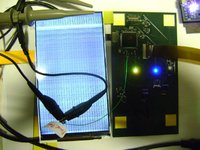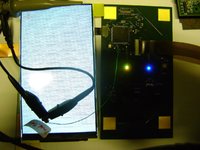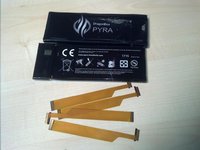Yay, I finally found the time to post some news!
Upgrading my shop (www.dragonbox.de) and visiting the "Lange Nacht der Computerspiele" ("Long night of computer games") in Leipzig, presenting the Pyra besides organizing various sides of Pyra development surely took quite a bit of time.
Let's start with...
1. The Rotator chip
We've come a long way here, Nikolaus, notaz and the Solomon Tech team were working together and we're not too far away from having it working properly!
There are a lot of parameters that have to be set to make it work, but most of them are now set up properly.
The only thing we're still working on are the timing settings for the video stream.
Setting up the chip and rotation are already working properly!
You can see that on the pictures:


As mentioned, the video stream is not yet setup, so the display simply displays whatever random stuff is in the RAM of the rotator chip, but it's stable and the rotation is working properly as well.
Once the timing settings are correctly calculated and applied to the video stream, that chapter can be closed as well.
2. The LCD Cable
The LCD cable as well as the battery samples have arrived - unfortunately, we need to rework the cable a bit.
Connecting the panel leads to some video, but it's not stable and the display is flickering.
This is because it seems the traces are currently too weak for the power we need to send through them.
Nikolaus is currently measuring which traces need more width or thickness so everything gets through properly.
Apart from that, the cable looks and feels fantastic

3. The Battery
The battery fits nicely and doesn't wiggle around as the Pandora battery (so no padding needed anymore).
We've not yet run extensive tests, but it provides power
As it's from the same manufacturer as the Pandora battery, we don't expect any issues here, as the Pandora battery has proved to be quite awesome
4. Some Power issues
Not all is well in Pyra-Land, but that's normal when doing some development.
Besides the LCD Cable, it seems some traces on the mainboard also are too thin for the power system.
The voltage that arrives at the LCD Panel is too little, and Nikolaus traced that down to be some traces.
He's now checking which ones exactly need to be a bit wider / thicker. It's no huge issue, but needs a bit of time to measure everything out.
So we're still moving forward. Some small issues like these were to be expected (we would be gods if everything worked fine from the beginning with such a complex system), but thankfully nothing major yet
I'll keep you posted
Upgrading my shop (www.dragonbox.de) and visiting the "Lange Nacht der Computerspiele" ("Long night of computer games") in Leipzig, presenting the Pyra besides organizing various sides of Pyra development surely took quite a bit of time.
Let's start with...
1. The Rotator chip
We've come a long way here, Nikolaus, notaz and the Solomon Tech team were working together and we're not too far away from having it working properly!
There are a lot of parameters that have to be set to make it work, but most of them are now set up properly.
The only thing we're still working on are the timing settings for the video stream.
Setting up the chip and rotation are already working properly!
You can see that on the pictures:


As mentioned, the video stream is not yet setup, so the display simply displays whatever random stuff is in the RAM of the rotator chip, but it's stable and the rotation is working properly as well.
Once the timing settings are correctly calculated and applied to the video stream, that chapter can be closed as well.
2. The LCD Cable
The LCD cable as well as the battery samples have arrived - unfortunately, we need to rework the cable a bit.
Connecting the panel leads to some video, but it's not stable and the display is flickering.
This is because it seems the traces are currently too weak for the power we need to send through them.
Nikolaus is currently measuring which traces need more width or thickness so everything gets through properly.
Apart from that, the cable looks and feels fantastic

3. The Battery
The battery fits nicely and doesn't wiggle around as the Pandora battery (so no padding needed anymore).
We've not yet run extensive tests, but it provides power
As it's from the same manufacturer as the Pandora battery, we don't expect any issues here, as the Pandora battery has proved to be quite awesome
4. Some Power issues
Not all is well in Pyra-Land, but that's normal when doing some development.
Besides the LCD Cable, it seems some traces on the mainboard also are too thin for the power system.
The voltage that arrives at the LCD Panel is too little, and Nikolaus traced that down to be some traces.
He's now checking which ones exactly need to be a bit wider / thicker. It's no huge issue, but needs a bit of time to measure everything out.
So we're still moving forward. Some small issues like these were to be expected (we would be gods if everything worked fine from the beginning with such a complex system), but thankfully nothing major yet
I'll keep you posted

